Stonehenge |
||
Stonehenge was built in stages over centuries, but the main activity involving the largest stones was probably completed around 2600-2500 BC, which is exactly the same century when the Egyptians were ruled by Khufu and later completed the Great Pyramid of Giza. The construction of monuments and burial areas, probably of religious and ceremonial significance, and probably examples of human nature coping with the mysteries and emotions inspired by death and human mortality was widespread in ancient Europe and Asia. North America and Africa also had (and still have) monuments of stone or wood circles aligned and arranged in ways that have astronomical significance. Our ancestors' ancient minds were certainly aware of the parallels between our mortal lives and the seasonal and celestial rhythms. Also, just as in modern societies, ancient systems of class and occupational stratification and hierarchical authority thrived when religious and political authorities could point to meaningful manifestations of social power. Monuments and areas associated with inter-generational continuity in the face of death and grief would naturally help powerful persons in ancient societies enforce belief systems that stabilized social organization and promoted cultural harmony. Great monuments and rituals associated with the monuments would probably inspire group pride, social cohesion, shared identities, and strong commitment to systems of values or laws. The oldest astronomically aligned megalithic structures are located in the Egyptian desert (near Nabta, in an area that was probably a lakeside grassland at the time), and date to about 4500-5000 BC. Megaliths and dolmen were raised all across the world, and can be found in Africa, Japan, Korea, Mongolia, China, and many nations of Europe, with particularly high concentrations in France and the British Isles. Stonehenge, located in the middle of southern England, is probably the most famous example. The technologies of astronomy, ramps, levers, earth-moving, stone-shaping, mathematics, trade, civil engineering, rope-making, and barge transport were evidently highly developed in those late neolithic and early bronze age cultures. The art of the people who lived in cultures of western Europe at the time Stonehenge was constructed show a fondness for abstraction, an emphasis on images of people and domesticated animals, and a great many swirling spiral patterns, reminiscent of fingerprints. Wavy and zig-zag lines are also common motifs. Some of these people valued highly polished stone axe heads. Structures such as homes were usually round or u-shaped. None have found any written records of what these people were doing or thinking, so much of what we say about them is speculative. Archeologists use the names "Funnel Beaker Culture" and the later "Bell-Beaker" or "Beaker Culture" to refer to these European cultures. Stonehenge offers us a rich opportunity for speculation. There was widespread trade during the Bronze Age, so we can wonder whether any explorers or merchants could have, in one lifetime, visited both the constructions sites in Egypt where the great early pyramids were being built and the area around Stonehenge. Even if no people moved between these cultures, ideas may have spread. How is it that Neolithic and early Bronze Age peoples in such widely distributed areas of the world came to the same idea of putting up giant stones or arranging stones into circles or rows? Did these ideas get passed around from tribe to tribe through trading and travel like ideas about animal domestication, bronze working, and the constellations? Stonehenge timeline: There can hardly be any chance of strong cultural continuity between the culture that had used the site from 3100 BC to 1400 BC and the Celtic cultures described by the Roman General (later Emperor) Julius in 54 BC. For example, the megalith builders were probably a pre-Indo-European-speaking group with different mythological stories and religious symbolism than those held by the Celtic people. The Basques, Sami, and Georgians are relic cultures speaking pre-Indo-European languages, and researchers have noticed some cultural similarities between old Basque customs and the likely practices of the people who built megalithic monuments. The 1000 years of the later Bronze Age and early Iron Age between the end of the use of the Stonehenge site and the genesis of the Celtic or British culture saw significant transitions in social organization and language. You can imagine that the culture of modern Americans differs very significantly from that of the Spanish, English, Dutch, French, African, and Swedish ancestors who settled here in the early 17th century or the Indians who were here when the newcomers arrived. Likewise, the Chinese culture has changed tremendously since the late Ming Dynasty. Yet, the gap in time between the the end of the use of Stonehenge and the entry of Britain into the historical record is three times the four-century span of years contemplated in these modern examples of cultural change. |
|
|
Links about Stonehenge: 1. The BBC has a short web video showing the development of Stonehenge over time. 2. The stonehenge property is managed by English Heritage, and they have a good website about the history of the site. 3. The National Geographic Society has sponsored some studies of Stonehenge, and they publicize the findings from these studies. Here is an article by James Owen about the use of Stonehenge as a cemetery, and here is an article about the village that existed around Stonehenge between 2600 and 2500 BC. 4. Professor Christopher L. C. E. Witcombe has a very fine page about Stonehenge. 5. The Miss Gien site has some examples of neolithic and bronze age stone circles. 6. Stephen J. Murray offers a fine introduction to the neolithic age in Britain.
|
Photo Gallery of Stonehenge. Photographs by Victor Ives. |
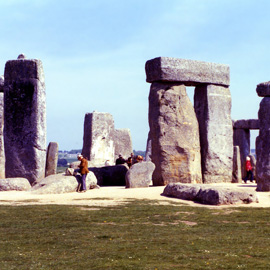 |
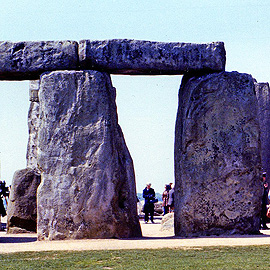 |
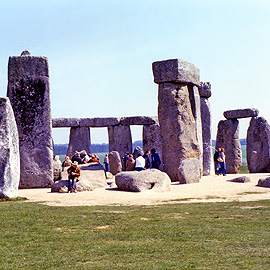 |
|
| Stonehenge on May 19, 1977. | Sarsen Stones | Stonhenge has been slightly restored. |
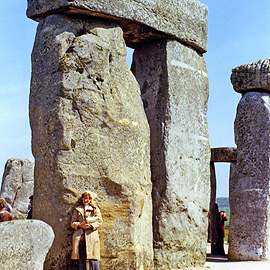 |
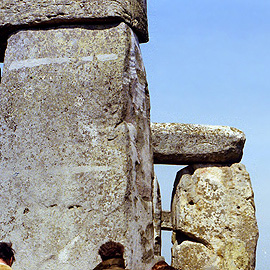 |
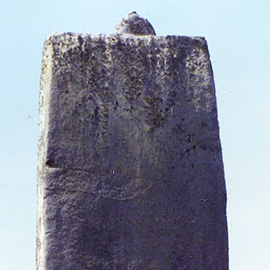 |
|
| Note the tremendous size of these stones and consider the difficulties associated with planning Stonehenge and getting the stones into place. | Here is a close view of some of the stones. | The knob on the top of this upright sarcen stone would fit into depressions hollowed out from the lintel caps, which have now fallen down. | |
| Back to the World History Timeline in English | |||

This work by Eric & Chun-Chih Hadley-Ives is licensed under a Creative Commons Attribution-NonCommercial-ShareAlike 4.0 International License.